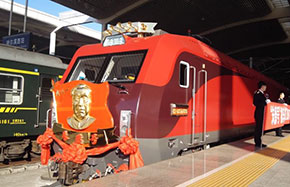Winter brings smog back on public agenda
Two weeks after the Ministry of Environmental Protection said air quality in the Beijing-Tianjin-Hebei region had improved in the first eight months of this year compared with the same period in 2015, the Beijing municipal government issued a blue alert for air pollution. And that five days later (on Oct 19) Beijing issued a yellow alert (the third-highest warning level) has pushed smog back into public discussion.
To begin with, the rebound in the industrial emission level has become a potential environmental threat. Recent efforts to stimulate the economy and increase the demand for real estate, along with rising housing prices, may be motivating the unexpected increase in production activities in the property sector. Statistics for September show crude steel production increased 3.9 percent year-on-year, and that of pig iron and steel production rose by 4.1 percent and 4.3 percent.
Industrial activities have remained robust, but emission control measures still fall short of the required level. The Ministry of Environmental Protection's inspections of 1,019 iron and steel manufacturing facilities showed 173 of them had violated emission norms.
Besides, a Greenpeace report says there is a correlation between industrial production and air quality: nearly half of the variation in the level of PM2.5 (pollutant particulate matter with a diameter of 2.5 micrometers or less) could be explained by the change in industrial activities. As coal still fuels a lot of industrial activities, industrial emission will continue to pollute the atmosphere.
Amid the rising fears against smog, reducing the use of coal for household heating has been put on the checklist of the pollution control agenda for this year. Yet compared with the upgrade of the enterprise-level end-pipe scrubber, it is much more difficult to persuade people to use new heating devices. As a result, the momentum to shift away from coal for domestic heating is still slow.
Efforts are being made, however, to shut down coal retailing outlets and substitute them with domestic boilers. But even with subsidies, the progress on this front is relatively slow.
Wind energy, too, has not helped much in the fight against environmental pollution. El Nino was blamed for the heavy smog in 2015, and things don't look good for this year either. Although members of the Chinese Academy of Sciences have warned that the influence of El Nino could make smog a frequent affair, the weather phenomenon is not the cause of smog. Since El Nino makes the impact of emissions more drastic, air pollution control efforts have to be intensified to counter the exacerbating effect of the weather phenomenon.
The fact is, temporary measures can only help reduce the problem, not solve it. The ministry's monthly reports show a year-on-year increase in the PM2.5 level in September 2016, indicating a short-term reversal in the progress of air pollution control. The use of temporary measures have indeed given us relatively clear skies during big events - such as the Beijing 2008 Olympic Games, 2014 APEC meeting, Victory Day parade in 2015 and the G20 Summit this year - and perhaps can make monthly pollution reviews propitious. Yet they alone cannot solve the emission problem.
Beijing issued two red alerts last year, and then said emergency measures had led to pretty good outcomes - 30 percent reduction in emissions and lowering of the PM2.5 level. But we are still facing the smog problem.
There is significant difference between dragging down peak values, providing evanescent blue skies and solving the air pollution problem. The need, therefore, is to work out a long-term road map to curb air pollution.
Smog is likely to mar not only this winter but also many winters in the future. Yet it is still unclear whether the high-level "national action plan for air pollution prevention control" or "air ten" will extend beyond 2017. The newly promulgated Air Pollution Prevention and Control Law does stipulate that local governments establish air pollution control road maps, but such plans should be made keeping in mind China's national air quality standard, in order to eventually reach the World Health Organization's air quality guideline standard. And until we come up with a long-term policy to control air pollution, the future color of the sky will remain a public worry.
The author is Greenpeace climate and energy campaigner.


















